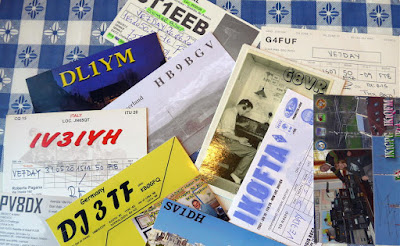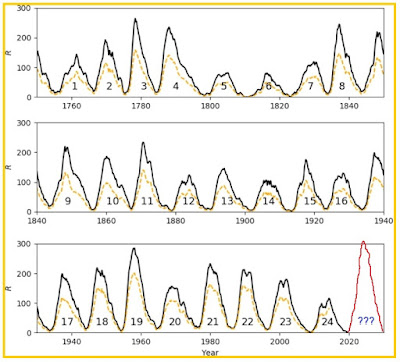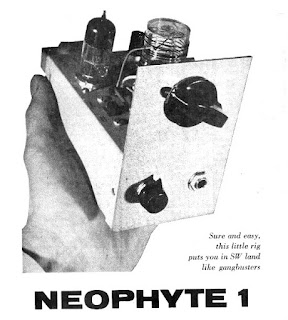Author Archive
 Hunting For NDBs In CLE260
Hunting For NDBs In CLE260
| ZQT-263 Thunder Bay, ON (ve3gop) |
It's CLE time again!
'CLE's are 'Co-ordinated Listening Events, and NDB DXers around the world focus their listening time on one small slice of the NDB spectrum.
This time the hunting ground is the slice from 260.0 - 269.9 kHz and 440 - 1740kHz.
Propagation on MF has been excellent this past week and hopefully will continue to be good.
A worthy target for listeners in North America is ZQT - 263kHz in Thunder Bay, southern Ontario, on the western shores of Lake Superior. ZQT has been logged from coast-to-coast but it's a challenging target. Listen for ZQT's upper sideband on 263.392kHz with your receiver in the CW mode.
When tuning for NDBs, put your receiver in the CW mode and listen for the NDB's CW identifier, repeated every few seconds. Listen for U.S. NDB identifiers approximately 1 kHz higher or lower than the published transmitted frequency since these beacons are modulated with a 1020 Hz tone approximately.
For example, 'AA' near Fargo, ND, transmits on 365 kHz and its upper sideband CW identifier is tuned at 366.025 kHz while its lower sideband CW ident can be tuned at 363.946 kHz. Its USB tone is actually 1025 Hz while its LSB tone is 1054 Hz.
Often, one sideband will be much stronger than the other so if you don't hear the first one, try listening on the other sideband.
Canadian NDBs normally have an USB tone only, usually very close to 400 Hz. They also have a long dash (keydown) following the CW identifier.
All NDBs heard in North America will be listed in the RNA database (updated daily) while those heard in Europe may be found in the REU database. Beacons heard outside of these regions will be found in the RWW database. These databases have recently been re-vamped and are slicker than ever before!
From CLE coordinator Brian Keyte (G3SIA), comes the following CLE info:
Hello all,
These are the final details for this weekend's Coordinated Listening Event which uses some challenging frequencies.
Any first-time CLE logs will also be very welcome, however modest.
Days: Friday 25 Sept. - Monday 28 Sept.
Times: Start and end at midday, your local time
Target: Normal NDBs (not NAVTEX or amateur beacons)
QRG: 260.0 - 269.9 kHz
plus: 440.0 - 1740.0 kHz
Please log the NDBs you can identify that are listed in those ranges plus any UNIDs that you come across there.
North America has a modest number of active NDBs in both ranges.
For Europe listeners there are LOTS of targets in the hf range, but they are mostly well to the east, many of them also competing with strong Broadcasting Stations.
Australia has a few NDBs in both ranges.
You can find details of the beacons in these ranges, lists and maps, if you go to http://www.ndblist.info/cle.htm and click on the 'CLE SEEKLIST' link.
If you are disappointed by having very few likely targets, you could maybe listen instead via a remote receiver located nearer to the action?
See kiwisdr.com (previously available via sdr.hu) and please also see the important footnote below.
Send your final CLE log to the List, preferably as a plain text email, not in an attachment, with CLE260 and FINAL at the start of its title.
Please show on EVERY LINE of your log:# The full Date (or Day no.) e.g. ‘2020-09-25’ (or just ‘25’) and UTC (the day changes at 00:00 UTC)
# kHz (the beacon's nominal published frequency if you know it)
# The Call Ident.
Other optional details - Location, Distance, etc. - go LATER in the same line (or in footnotes) Any extra details about new UNIDs, especially strong ones that may be near to you (maybe their approximate direction, etc.) will help us to discover more about them.
Please make your log useful to old and new members alike by ALWAYS including your own location and brief details of the equipment and aerial(s) that you were using.
We will send an 'Any More Logs?' email at about 19:00 UTC on Tuesday evening so you can check that your log has been found OK.
To be included in the combined results your log must arrive at the very latest by 08:00 UTC on Wednesday 30 Sept.
We hope to complete making the Combined Results within a day or two.
Good listening
Brian and Joachim
---------------------------------------------------------------------
From: Brian Keyte G3SIA ndbcle'at'gmail.com
Location: Surrey, SE England (CLE coordinator)
---------------------------------------------------------------------
If you are interested in some remote listening - maybe due to local difficulties - you could use any one remote receiver for your loggings,stating its location and with the owner’s permission if required.
A remote listener may NOT also use another receiver, local or remote, to make further loggings for the same CLE.
These listening events serve several purposes. They
• determine, worldwide, which beacons are out-of-service or have gone silent since the last CLE covering this range
• will indicate the state of propagation conditions at the various participant locations
• will give you an indication of how well your LF/MF receiving system is working
• give participants a fun yet challenging activity to keep their listening skills honed
Final details can be found at the NDB List website, and worldwide results, for every participant, will be posted there a few days after the event.
The NDB List Group is a great place to learn more about the 'Art of NDB DXing' or to meet other DXers in your region. There is a lot of good information available there and new members are always very welcome. As well, you can follow the results of other CLE participants from night to night as propagation is always an active topic of discussion.
You need not be an NDB List member to participate in the CLEs and all reports, no matter how small, are of much value to the organizers.
Remember - 'First-time' logs are always VERY welcome!
Reports may be sent to the NDB List Group or e-mailed to CLE co-ordinator, Brian Keyte (G3SIA), whose address appears above. If you are a member of the group, all final results will also be e-mailed and posted there.
Please ... give the CLE a try ... then let us know what NDB's can be heard from your location! Your report can then be added to the worldwide database to help keep it up-to-date.
Have fun and good hunting!
 Just One More dB!
Just One More dB!

*** The following blog was originally published in 2016 but is still very applicable in 2020! ***
How often have you struggled to pull a weak signal out of the noise? "Just give me one more db", you tell yourself.
A recent posting to the Topband reflector by Frank, W3LPL, sent me to the interesting webpage of Dave, AB7E. Dave had been pondering two antenna systems, one of which would provide a 2db improvement in forward gain but at a much higher cost ... he wondered if the extra expense would be worthwhile and could he even hear the difference that 2db would make? He created a series of CW files, incrementing the signal level in 1db steps to see for himself!
Now I've always been told that you need to increase signal strength by at least 3db before your ears can detect any difference ... but listen carefully and you may be in for a surprise, as AB7E discovered.
It's probably best to listen to this signal with headphones but, even on my I-Pad's tiny speaker, the demonstration is clear. The first recording starts at "zero db", which is sent twice while the next signal is "one db", sent twice. See if you can hear the difference between each 1 db increment as he steps up to "six db":
Try going the other way, from "six db" down to "zero db":
The following recording has two signals, one of which is one db louder then the other. Can you hear the difference?
Although I was able to hear one call slightly better than the other, it was difficult. How about two signals again, one of them being 2db louder this time ... this one is much easier:
Lastly, AB7E demonstrates the problem with sending too fast when conditions are very marginal. Here, several signals are sent at 20, 25, 30 and 35 WPM. Sending calls at high speed can often seem effective, even under poor conditions but this seems to demonstrate that slowing down just a bit would make it somewhat easier:
One of the more interesting comments posted regarding these recordings was from Bob, N6RW who cited his work in satellite communications:
"I spent part of my engineering career designing satellite command FSK
demodulators - including the deep space Pioneer Venus orbiter. To test
the performance of them, we would mix the test signal with white noise.
When you look at the FSK Bit-Error-Rate (BER) curve (bit errors versus
signal to noise ratio in a bandwidth equal to the bit rate), you can see
the BER improves by a factor of 10 to 1 for every dB in S/N ratio. In
other words, for every dB improvement, you get one tenth the errors."
Now Dave never did tell us if he bought the bigger antenna or not but I'm betting that he did ... it looks like "just one more db" may really be just enough after all.
 Hunting For NDBs in CLE259
Hunting For NDBs in CLE259
| YPM-274 Pikangikum, ON (ve3gop) |
It's CLE time again!
'CLE's are 'Co-ordinated Listening Events, and NDB DXers around the world focus their listening time on one small slice of the NDB spectrum.
This time the hunting ground is the 50kHz slice from 270.0 - 319.9 kHz. kHz
A worthy target for listeners in North America is YPM (274Hz) in Pikangikum, in western Ontario. YPM has been logged from coast-to-coast and out to Hawaii. Listen for YPM's upper sideband on 274.361kHz with your receiver in the CW mode.
When tuning for NDBs, put your receiver in the CW mode and listen for the NDB's CW identifier, repeated every few seconds. Listen for U.S. NDB identifiers approximately 1 kHz higher or lower than the published transmitted frequency since these beacons are modulated with a 1020 Hz tone approximately.
For example, 'AA' near Fargo, ND, transmits on 365 kHz and its upper sideband CW identifier is tuned at 366.025 kHz while its lower sideband CW ident can be tuned at 363.946 kHz. Its USB tone is actually 1025 Hz while its LSB tone is 1054 Hz.
Often, one sideband will be much stronger than the other so if you don't hear the first one, try listening on the other sideband.
Canadian NDBs normally have an USB tone only, usually very close to 400 Hz. They also have a long dash (keydown) following the CW identifier.
All NDBs heard in North America will be listed in the RNA database (updated daily) while those heard in Europe may be found in the REU database. Beacons heard outside of these regions will be found in the RWW database. These databases have recently been re-vamped and are slicker than ever before!
From CLE coordinator Brian Keyte (G3SIA), comes the following CLE info:
Hello all
Here are brief details for our 259th co-ordinated listening event next weekend.
It spans a 50 kHz frequency range - about three times wider than usual.
In that range, the Rxx database is showing about 200 active NDBs located in
Europe, 135 in North America, 35 in Oceania and about 250 more, scattered
in other parts of the World.
Days: Friday 28 August – Monday 31 August
Times: Start and end at midday, your LOCAL time
Range: 270.0 - 319.9 kHz (NDB signals only)
Part of the frequency range also has DGPS signals among the NDBs.
We last listened on these frequencies in CLE243 in April 2019.
Any first-time CLE logs will be very welcome, as always.
Please look out for our Final Details on the NDB List website, with full advice on log making, etc.,
in a few days.
Brian and Joachim
-----------------------------------------------------------------
From: Brian Keyte G3SIA ndbcle'at'gmail.com
Location: Surrey, SE England (CLE coordinator)
-----------------------------------------------------------------
These listening events serve several purposes. They:
• determine, worldwide, which beacons are actually in service and on-the-air so the newly-re-vamped Rxx online database can be kept up-to-date
• determine, worldwide, which beacons are out-of-service or have gone silent since the last CLE covering this range
• will indicate the state of propagation conditions at the various participant locations
• will give you an indication of how well your LF/MF receiving system is working
• give participants a fun yet challenging activity to keep their listening skills honed
Final details can be found at the NDB List website, and worldwide results, for every participant, will be posted there a few days after the event.
The NDB List Group is a great place to learn more about the 'Art of NDB DXing' or to meet other DXers in your region. There is a lot of good information available there and new members are always very welcome. As well, you can follow the results of other CLE participants from night to night as propagation is always an active topic of discussion.
You need not be an NDB List member to participate in the CLEs and all reports, no matter how small, are of much value to the organizers.
Remember - 'First-time' logs are always VERY welcome!
Reports may be sent to the NDB List Group or e-mailed to CLE co-ordinator, Brian Keyte (G3SIA), whose address appears above. If you are a member of the group, all final results will also be e-mailed and posted there.
Please ... give the CLE a try ... then let us know what NDB's can be heard from your location! Your report can then be added to the worldwide database to help keep it up-to-date.
Have fun and good hunting!
 Some 6m Summer Excitement
Some 6m Summer Excitement

With three seasons of FT8 under its belt, there’s no doubt that it's taken over as the number-one mode for the 6m band ... there are very few traces of CW or SSB to be found.
What it hasn’t taken away, is the magic!
For the most part, this summer’s conditions from the west coast were pretty normal, except for when they weren’t ... and when they weren’t, they were pretty spectacular!
The spectacular parts were highlighted by one particularly unique contact that can only be attributed to some heads-up operating skills, a little help from FT8 ... and the unpredictability of Sporadic-E.
On June 20, at 0056Z, K7CW (Paul), south-west of Seattle, nudged his signal all the way to Hong Kong, more specifically, to VR2ZXP’s crowded apartment building. But that’s not the incredible part. That happened when Paul heard and exchanged signal reports with Alfred’s tiny station!
 |
| Paul, K7CW |
 |
| Not the best location for weak signal 50MHz DX! |
"As I told to Paul, it’s a hard job to be a ham in VR2 Hong Kong especially for the DX. Hong Kong is a high density population city. 99% people are living in apartment only. The housing price here is crazy around US$1800 per sq. feet. Neighborhoods always complain why we setup antennas out of our windows and produce radiation to affect their health. So, what we just can do is to use a small whip with QRO for the QSO. Besides, interference is also serious. Thousands of air conditioner is surrounding me and a power station 132kV to 11kV is just faced to me in 1km away. Here the noise level on low HF band at night is S9."
As indicated above, Alfred’s station is located in a typical high-rise apartment, surrounded by numerous others, with no room for antennas. His solution is to clip a short (60”) whip antenna, horizontally mounted on his balcony railing, similar to this one from 20 years ago ... before being surrounded by noisy high-rise apartment buildings!
I’m not sure which is the most spectacular part of this contact ... that Alfred could detect Paul’s signal in such a noisy environment using such a small makeshift antenna or that Paul was able to copy the tiny signal coming from uptown Hong Kong.
 |
 |
| K7CW's 9el - 50' Yagi at 80' |
Long openings like this occur very rarely, making them even more thrilling and can cause even the most experienced 6m DXer’s mouse-hand to tremble with excitement!
 |
| Some of VE7DAY's wallpaper from the May 31st opening. |
Others up and down the west coast also filled their log pages with ‘new ones’ ... unfortunately my exciter was on the workbench while replacing the screen so I never knew what I had missed until some time later ... probably just as well. I guess I must have been pretty naughty at some point, as the 6m gods definitely singled me out for special punishment that morning.
Once the exciter was back together I was able to catch a few good openings myself, the best of which was early on the morning of June 23 when I was able to work SV9CVY (Crete), SV1DH (Greece) and IS0AWZ (Sardinia).
Crete and Sardinia gave me DXCC #89 and #90. Three days later, during a nice opening to the southern states, J68HZ in St. Lucia snuck through the QRM for #91. After a further three days, on June 29, another very early opening put 8 more Europeans in the log including HA8CE (Hungary) and YU7EF (Yugoslavia) for #92 and #93 respectively.
The band also produced several long openings to Asia, usually in the late afternoon hours. Several contacts were made with South Korean stations, China and dozens with Japan.
All told, the band produced some exciting activity this summer. Countries worked here were:
JA, JW, TG, V31, J68, LA, SM, SV9, SV, IS0, EA, HA, YU, F, 9A5, BG, HL, EA8. Certainly FT8 had much to do with a good portion of the action but it is difficult to say just how much. Many of the Europeans were very strong and could have easily been worked on CW in a matter of a few seconds, rather than the 60 - 75 seconds required for a valid FT8 exchange, assuming there are no repeats. But it's contacts like Paul and Alfred's that continue to validate the special name given to the band ... you just never know what might tricks will be next.
 New Hope For Cycle 25!
New Hope For Cycle 25!

Unlike most forecasts for solar Cycle 25, a recently released paper from five solar scientists (1) has given many 6m diehards new reasons to hope!
After countless dire predictions for the upcoming cycle indicating similar or even poorer activity levels than the disappointing Cycle 24, the new paper suggests just the opposite!
In fact, the group of scientists predict that "Cycle 25 will probably be among the strongest solar cycles ever observed, and that it will almost certainly be stronger than present SC24 (116 spots) and most likely stronger than the previous cycle 23 (180 spots)." The possibility of a smoothed sunspot number (SSN) reaching as high as 305 is in the prediction!
Solar Cycle 19 was a monster, reaching a SSN level of 285 ... to imagine the possibility of something even stronger is truly exciting. The just-ending Cycle 24 was one of the weakest on record, reaching an SSN of just 116.
 |
| Will Cycle 25 replace Cycle 19 as #1? Image source with my addition in RED. |
During Cycle 24, maximum usable frequencies (MUF) for F2 propagation often struggled just to reach 28MHz, and except for the peak year, the worldwide propagation conditions that amateurs had come to expect were often absent.
Should these new optimistic predictions come to pass, 6m operators can look forward to some truly, never-before-seen, fall and winter propagation ... for at least three or more winters.
With SSN values reaching the high two-hundreds or beyond, west coast operators can expect to see the 6m band often open before sunrise, most likely favoring Europe via the polar path or towards Africa via the trans-Atlantic path. Unlike 20m, there will be little to no ‘polar flutter’ and since signals propagating near the F2 MUF suffer very little path loss, they will probably be very strong.
Later in the day, propagation will shift south towards Central and South America before moving to the west. Depending on the time of year, the propagation will favor Asia, with signals from Japan, China and other far-eastern exotica in the early fall through the New Year. As well, the band will often stay open for some time after local sunset. Late winter and spring will see the western path favour signals from down under, and stretch out to the southern far east regions towards the Indian Ocean. These were the propagation patterns noted from here during Cycles 21-23, when SSNs reached 233, 214 and 180 respectively.
With much gratitude to Mark (VA7MM) for converting my old analog tapes to mp3, here is a recording I made on the morning of November 7, 1979, at the height of Cycle 21. It will give you a taste of what could be in store. On that Wednesday morning, the band opened around 0800 and continued through to sunset, closing with a three-hour opening to the Pacific and Japan. Like many other 6m operators, I had taken the day off work with a case of the 'F2 flu' that was very prevalent that winter! The recording begins with a short exchange between VE1ASJ and VE1AVX, while trying to work their first KL7 ...
The graph of Cycle 21 shows when the recording was made. Although not known at the time, it was very close to the peak of the cycle.
 |
| courtesy: http://www.solen.info/solar/ |
 |
| courtesy: http://www.solen.info/solar/ |
A record-busting Cycle 25 will be like these previous cycles only on steroids! With such a cycle, 10m will follow a similar pattern but will likely be open 24/7 as I recall listening to VKs and ZLs on 10m AM well after midnight during the downward climb of Cycle 19 ... and this was on a very '10m-deaf' Hallicrafters S-38 and a short wire out the attic window!
For those wanting to read the fascinating paper (Overlapping Magnetic Activity Cycles and the Sunspot Number: Forecasting Sunspot Cycle 25 Amplitude), you can find a pdf here. As well, you can read the ARRL’s own announcement of this exciting possibility here.
One certainty is, that if FT8 is still around by then, it and your soundcard will fold up quickly once the band opens with wall-to-wall S9++ signals. It may be useful during the first early minutes or during marginal openings, but knowing the signal levels that 6m F2 can produce, it will be like trying to use FT8 with dozens of new neighbors operating on your own block ... and you can easily guess how well that might work! As we’ve come to understand, FT8 is a wonderful weak-signal mode, but throw just one bone-crushing signal into the waterfall and it’s game-over ... on F2, there will be dozens of these!
Such stellar conditions on 6m are ideally suited to CW or SSB and I think there will be a fast exodus from FT8 back to the traditional modes very early ... those that aren’t prepared for this, relying only on FT8, will most likely be in for a rude awakening. If you’re a 6m “no-coder”, now’s the time to hunker-down and learn CW ... by the time Cycle 25 becomes productive, you won’t be left out of the many CW DX opportunities that will surely be available on this much quicker QSO mode.
We will no doubt be reading more about this as Cycle 25 begins to grow. As in almost all stronger than normal cycles, growth from the start to the peak is much shorter than normal so I’ll be watching for a fast rise in sunspot numbers once we are really underway.
Hindcast modelling (backtesting) of the data derived from previous cycles going back to the 1700s using the paper’s prediction methodology, shows an accurate alignment with what actually occurred. The red dots in the graph above indicate the model’s predicted peak superimposed on the actual peak. In some cases, the peaks were even higher than the modelling suggested.
The predictions identify the so-called “termination” events, landmarks marking the start and end of sunspot and magnetic activity cycles, extracting a relationship between the temporal spacing of terminators and the magnitude of sunspot cycles. The success of these predictions will depend upon an upcoming terminator event before the end of 2020. Should it occur on time, the predictions will be given a much greater chance of coming to fruition ... "with a terminator event in 2020, we deduce that sunspot cycle 25 will have a magnitude that rivals the top few since records began. This outcome would be in stark contrast to the community consensus estimate of sunspot cycle 25 magnitude."
More interesting discussions of the paper can be found here and here.
This week's high-latitude Cycle 25 sunspots are a great sign. When the terminator event occurs, solar activity will ramp-up very quickly, within one 27 day solar rotation. Let's hope we're getting close.
As noted in the paper, "Very early indications of the spot pattern are appearing at higher than average latitudes. Historically, high latitude spot emergence has been associated with the development of large amplitude sunspot cycles — only time will tell."
Hopefully we’ll all need to hold on to our hats ... it just might just be the ride of our lives!
(1) Scott W. McIntosh (1), Sandra C. Chapman (2), Robert J. Leamon (3,4), Ricky Egeland (1), and Nicholas W. Watkins (2,5,6)
1 National Center for Atmospheric Research, P.O. Box 3000, Boulder, CO 80307, USA.
2 Centre for Fusion, Space and Astrophysics, University of Warwick, Coventry CV4 7AL, UK
3 University of Maryland, Department of Astronomy, College Park, MD 20742, USA.
4 NASA Goddard Space Flight Center, Code 672, Greenbelt, MD 20771, USA.
5 Centre for the Analysis of Time Series, London School of Economics and Political Science, London WC2A 2AZ, UK
6 School of Engineering and Innovation, STEM Faculty, The Open University, Milton Keynes, UK
 Hunting For NDBs In CLE258 – Pick Five!
Hunting For NDBs In CLE258 – Pick Five!

Next weekend's CLE is something a little different. Listeners are asked to pick five frequencies only, to listen on, and then find as many beacons as they can!
During these stressful times, CLE258 might provide some much needed distraction for you.
I'm sure most listeners will find their own strategy for picking their five frequencies. Will it be the five that have given you the most loggings? The five that have provided the most loggings in North America or Europe? Will it be the five that are not being bothered by your stronger pest signals? Choose wisely and enjoy the challenge.
From CLE coordinator Brian Keyte (G3SIA), comes the following CLE info:
-----------------------------------------------------------------------
- determine, worldwide, which beacons are actually in service and on-the-air so the online database can be kept up-to-date
- determine, worldwide, which beacons are out-of-service or have gone silent since the last CLE covering this range
- will indicate the state of propagation conditions at the various participant locations
- will give you an indication of how well your LF/MF receiving system is working
- give participants a fun yet challenging activity to keep their listening skills honed
The NDB List Group is a great place to learn more about the 'Art of NDB DXing' or to meet other listeners in your region. There is a lot of good information available there and new members are always very welcome. As well, you can follow the results of other CLE participants from night to night as propagation is always an active topic of discussion.
You need not be an NDB List member to participate in the CLEs and all reports, no matter how small, are of much value to the organizers.
Remember - 'First-time' logs are always VERY welcome!
Reports may be sent to the NDB List Group or e-mailed to CLE co-ordinator, Brian Keyte (G3SIA), whose address appears above. If you are a member of the group, all final results will also be e-mailed and posted there.
Please ... give the CLE a try ... then let us know what NDB's can be heard from your location! Your report can then be added to the worldwide database to help keep it up-to-date.
Have fun and good hunting!
 NEOPHYTE Adventures
NEOPHYTE Adventures
I've just added a new page to my website, The VE7SL Radio Notebook, that describes my NEOPHYTE 1 regenerative receiver spring construction project. The new page can be found here.
Like most simple regens, its performance far exceeds its simple circuit expectations. My listening adventures with it continue during The Radio Board's annual Homebrew DX Contest which runs from July 11 - 24th. You may want to give it a try, after of course, you've checked-out my new web page!






















